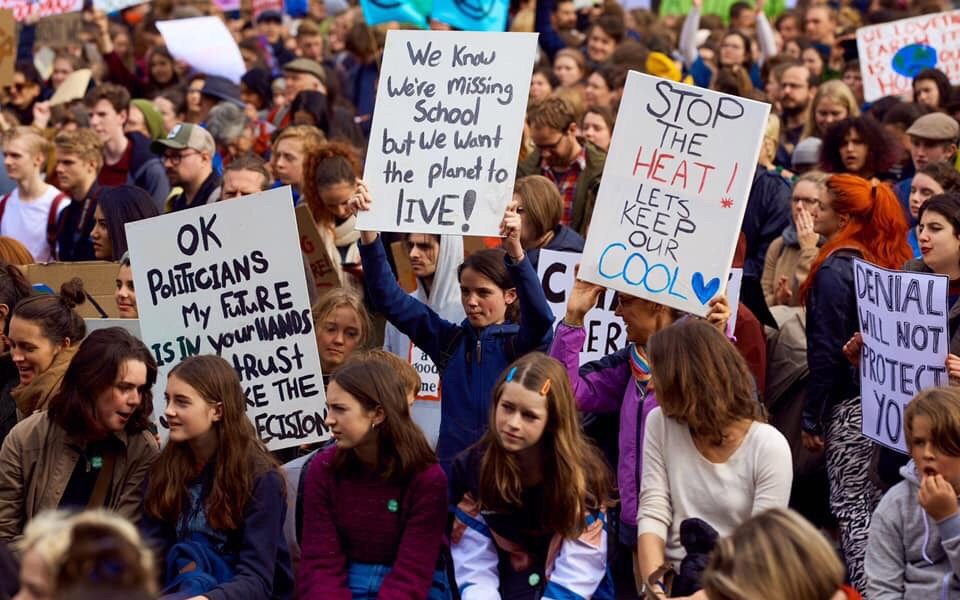Image Description: A large sea of young people in an urban area, all protesting. They all have stern faces, some with a sense of anger. A few signs are held containing words such as “We know we are missing school but we want the planet to live!” and “Stop the heat! Let’s keep our cool”.
By Aden Curran
This is part two of the interview with Extinction Rebellion (XR) member Tamara. To read part one, click here.
Aden Curran: What are the kind of people who typically get involved in XR?
Tamara: That’s a hard question for me to answer right now. Environmental activism remains a very middle class, white movement, and I think that is something that has been discussed only a little bit in the broader realm of activism. It’s something that has been sitting closely to my heart for a couple of months now and it’s definitely something that I’d like to see a big shift occur in.
To me, I’m excited by the involvement that we’ve been able to achieve with First Nations peoples and Elders in the community, and tonight for our last Reading we’ll have Aunty Corina, a Bibbulmun Elder, involved. I’d like to see us integrate more with these communities and have a broader, wider audience of people; we had a person involved for a few days during the Reading and they weren’t feeling super confident on the stage, so I’d really like to see Extinction Rebellion make more space for people that aren’t just fitting into this very specific category of ‘activist’ at the moment. I know that there are spaces like this coming forward, but I think there’s always room for improvement.
I really believe that the crisis that we’re facing now is due to colonisation and due to patriarchy, so, for me, I’d really like to see this movement led by someone other than that who fits into the role of “Caucasian, privileged, middle class”; I think this movement really needs to be led by people that have been essentially ignored for centuries—we have so much to learn from those groups.
XR is a diverse movement. But how accessible is the movement to people that don’t fit within the confines of the very privileged, or those who can take time off work, work a part-time job, or can protest climate change and not just worry about surviving? We’re constantly striving for reconciliation, and I think XRWA have done a great job of having First Nations peoples lead the movement, but they need to lead more, and they need to lead now. We need to be building those spaces for these people and hearing not just from white people, essentially.
I wish that this wasn’t just me, I wish that we had more spaces for people to come and be involved, but I understand our current limitations. It’s a tricky, tricky question at the moment. This movement needs more voices and we need to be creating space to be led, rather than to lead.
AC: Do you have any opinions on, or thoughts on how these spaces for new voices could be created?
T: The sort of structures that Extinction Rebellion already have are a great system to look at in creating People’s Assemblies, which I did see happen in London during the October Rebellion. This involves making sure that everyone in the decision-making process can be heard, and that there is always diversity (be it gender or racial) on the panel, when people liaise with authorities, people MCing, leading processions, leading workshops—that’s a big priority of Extinction Rebellion globally, to ensure that there is balance.
So, I think just adhering to those systems more and being aware if those systems are failingor when we have too many voices that are causing imbalances. We always need to make sure people feel comfortable and safe, and really look into the concept of People’s Assemblies, where everyone has a vote and everyone has an opinion which is heard and compiled.
AC: I’ve always been quite glad to observe the presence of First Nations people at the head of the protests and the Bushfire Vigil. I thought it was really good to see that.
T: Yeah, that was great to see. There’s been a big focus on creating that relationship and having it at the front of the movement, because, again, we know that we wouldn’t be in this problem if we had listened hundreds of years ago. It’s an unfortunate time to start listening, but I can see it has become a big focus of the movement for the last eight months.
AC: What would you say to people who might be interested in joining Extinction Rebellion, but they might have some reservations about it—maybe they think it seems a bit radical or daunting?
T: Oh, that’s a hard one, because I want to be able to say “do it, you won’t regret it,” and I think that you will probably feel the same way! I feel like there’s so many things that being in a movement like XR allows you to learn and to unlearn. The biggest thing I’ve unlearnt is that there’s absolutely nothing wrong with breaking rules and creating new systems and ideas for how we can do things. It’s created so much empowerment in my life and in the lives of other people that are involved.
Be ready for your whole idea of what the world looks like to change. Extinction Rebellion has amazing ideas about the future, and it’s really hopeful, and a really safe space, and it’s a big party most of the time—a lot of fun!
Tamara has created an affinity group called XR Festivals, which organises events like 1.5 Degrees Live and anyone is welcome to join. There is also a public discussion group that you can find on Facebook.
Image courtesy of XR.

